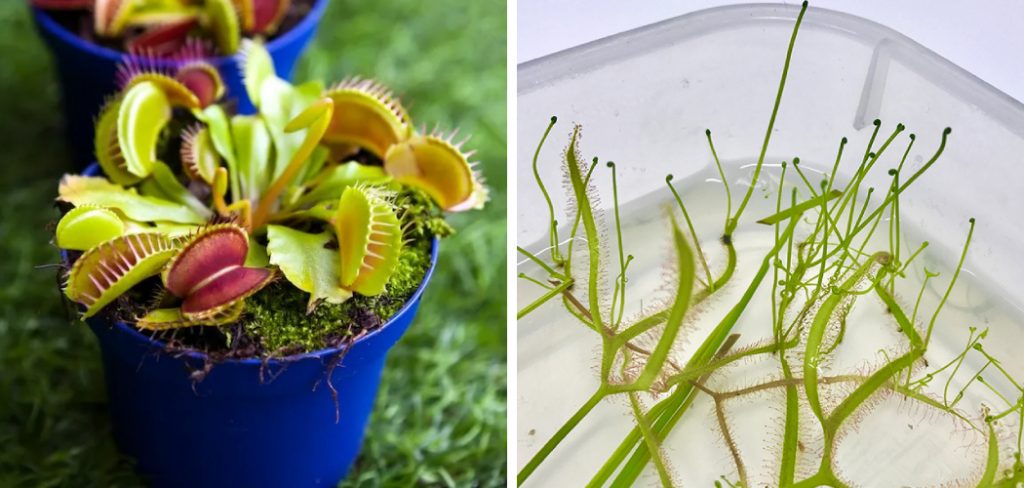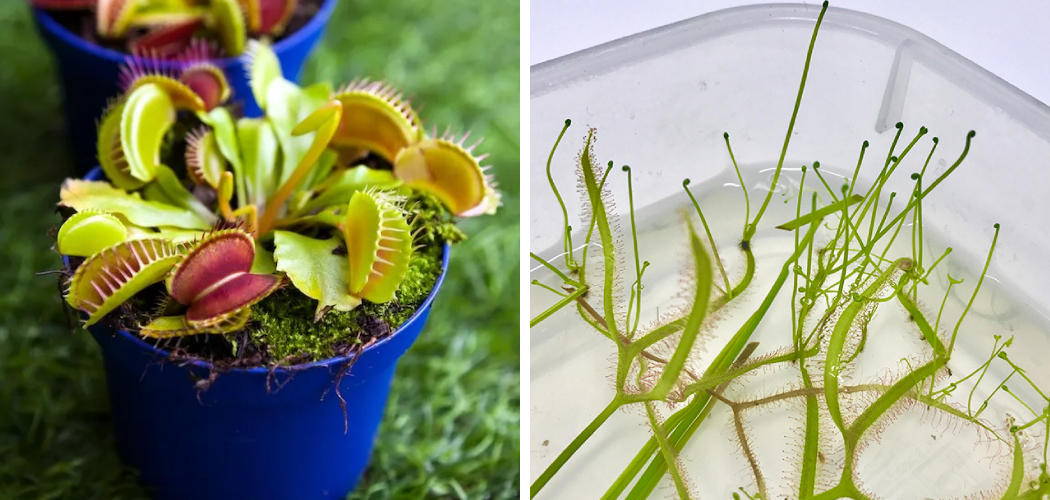To water carnivorous plants, use distilled water or rainwater, avoiding tap water that contains minerals and chemicals harmful to these plants. Carnivorous plants require special care when it comes to watering.
To keep these unique plants healthy, it’s important to provide them with the right kind of water. Tap water, which typically contains minerals and chemicals, can be harmful to carnivorous plants. Instead, opt for distilled water or rainwater, both of which are free from harmful additives.
By adhering to this watering practice, you can ensure that your carnivorous plants thrive and continue to capture and consume insects as part of their natural diet. Here’s a guide on how to water these fascinating plants and provide the ideal conditions for their growth.

Understanding The Unique Watering Needs Of Carnivorous Plants
Understanding the unique watering needs of carnivorous plants is crucial. These plants have fascinating adaptations for capturing and digesting insects, which also affects their water requirements. Their specialized mechanisms, such as pitcher traps and sticky hairs, enable them to catch and consume prey.
However, these adaptations also mean that carnivorous plants often live in nutrient-poor environments, relying on insects for essential nutrients. Consequently, their water needs differ from those of typical plants. Carnivorous plants thrive in moist but well-drained soil, avoiding waterlogged conditions that can lead to root rot.
They prefer distilled or rainwater, as tap water often contains minerals that can harm them. Regular watering is necessary, but ensuring the soil is always slightly damp rather than saturated is crucial. By understanding and meeting the unique watering needs of carnivorous plants, gardeners can provide the optimal conditions for these intriguing and captivating species.
How to Water Carnivorous Plants: Step by Step Guide
Watering Carnivorous Plants
Watering carnivorous plants properly is essential for their health and development. When watering these unique plants, it is important to choose the right water source to meet their specific needs. To maintain optimal humidity and moisture levels, avoid overwatering or letting the soil dry out completely.
Balancing these levels is crucial for the plants’ wellbeing. Consider using distilled or rainwater, as tap water may contain minerals harmful to carnivorous plants. The potting media used should have good drainage and retain some moisture. Avoid using regular garden soil, as it can suffocate the roots and damage the plants.
Instead, opt for a mixture of sphagnum moss, perlite, and sand for better aeration and water flow. By following these best practices for watering carnivorous plants, you can ensure their survival and enjoy their fascinating characteristics in your garden.
Establishing A Watering Routine For Carnivorous Plants
Establishing a watering routine for carnivorous plants involves assessing the soil’s moisture content. By regularly checking the soil, you can determine the appropriate watering frequency. Several factors influence this frequency, including the plant’s species, size, and environmental conditions. Different carnivorous plants have varying water requirements, so it’s crucial to understand the specific needs of each species.
For example, while some carnivorous plants prefer consistently moist soil, others may require periods of drying out between watering. Additionally, factors like temperature, humidity, and light levels also impact watering needs. By considering all these factors, you can develop a watering routine that ensures the health and vitality of your carnivorous plants.
Remember to always use distilled water or rainwater to avoid introducing chemicals that could harm the plants.
Proper Watering Techniques For Carnivorous Plants
Proper watering techniques for carnivorous plants are essential to ensure their health and survival. One of the common mistakes to avoid is using tap water, as it contains minerals that can harm these plants. Instead, it is crucial to use distilled or rainwater, which mimic their natural habitat.
Distilled water can be easily obtained from stores, whereas rainwater can be collected and stored for future use. When watering carnivorous plants, it is important to moisten the soil thoroughly without creating waterlogged conditions. This can be achieved by using a saucer or tray filled with water that the plant’s pot can sit in.
This method ensures that the roots are hydrated while preventing the plant from sitting in stagnant water for prolonged periods. By following these watering techniques, you can provide a thriving environment for your carnivorous plants.
Monitoring And Adjusting Watering For Carnivorous Plants
One important aspect of caring for carnivorous plants is monitoring and adjusting their watering needs. Overwatering and underwatering can have detrimental effects on these unique plants. To avoid overwatering, pay attention to signs such as wilting, discoloration, or a rotten smell.
On the other hand, underwatering can cause the plants to dry out and become weak. Adjusting watering practices based on the plant’s growth stage is essential. Younger plants may require more frequent watering, while older ones have more established root systems and can tolerate longer periods between watering.
Additionally, different species of carnivorous plants have varying water needs. Research each species to understand its specific requirements and adapt your watering practices accordingly. By monitoring and adjusting watering based on signs of overwatering and underwatering, as well as considering the plant’s growth stage and species, you can successfully care for your carnivorous plants and help them thrive.
Troubleshooting Water-Related Issues In Carnivorous Plants
Carnivorous plants can sometimes encounter water-related issues that can impact their overall health. One common problem is stagnant water, which can lead to mold growth. To prevent this, ensure proper drainage by using well-drained soil and pots with drainage holes.
Another issue is mineral and nutrient deficiencies, which can hinder plant growth. Address this by using distilled or rainwater instead of tap water, which may contain high levels of minerals. Additionally, you can fertilize the plants with specialized carnivorous plant food or diluted liquid fertilizer.
Root rot is another concern, caused by excessive moisture. To prevent this, water the plants only when the top layer of soil feels dry. Avoid letting the plants sit in standing water and remove any excess water from the trays.
By following these strategies, you can troubleshoot water-related issues and maintain healthy carnivorous plants.
Tips For Watering Carnivorous Plants In Different Environments
Watering carnivorous plants in different environments requires careful consideration. For indoor cultivation, it’s important to take into account specific water needs. When growing carnivorous plants outdoors, managing water requirements becomes crucial. Terrariums and bog gardens offer different strategies for watering these unique plants.
By understanding the specific needs of each environment, you can ensure optimal plant growth. Whether it’s providing adequate moisture levels indoors or finding the right balance in an outdoor setting, watering carnivorous plants requires attention to detail. So, remember to monitor the watering needs of your plants regularly and adjust accordingly.
With proper care and attention, you can enjoy the beauty and fascination of these intriguing plants.
Frequently Asked Questions For How To Water Carnivorous Plants
How Often Should I Water Carnivorous Plants?
Carnivorous plants should be watered with distilled or rainwater every few days. The soil should be kept moist but not waterlogged. It’s important to avoid using tap water or fertilizers, as they can harm these unique plants.
Can I Use Tap Water To Water My Carnivorous Plants?
Tap water should be avoided when watering carnivorous plants. Most tap water contains minerals and chemicals that can be harmful to these sensitive plants. Instead, opt for distilled or rainwater to ensure the best care for your carnivorous plants.
How Do I Know If My Carnivorous Plant Needs Water?
Carnivorous plants show signs of dehydration when they need water. Look for wilted or drooping leaves, as well as a dry soil surface. To test the moisture level, gently press your finger into the soil. If it feels dry, it’s time to water your carnivorous plant.
Can I Use Any Type Of Water To Water My Carnivorous Plants?
It’s best to use distilled or rainwater when watering carnivorous plants. These plants are sensitive to the minerals and chemicals found in tap water. To ensure their health and growth, provide them with clean, pure water that mimics their natural environment.
Conclusion
Overall, properly watering carnivorous plants is essential for their health and survival. These unique plants have specialized needs, requiring a careful balance of moisture and nutrients. By understanding their specific requirements and using the right techniques, you can ensure their long-term well-being.
Remember to always use distilled or rainwater, avoid tap water, which may contain harmful minerals. Providing a shallow tray or bowl filled with water, as well as misting the leaves, helps maintain the necessary humidity levels. It is crucial to water carnivorous plants consistently but not excessively, as waterlogged soil can lead to root rot.
Pay attention to individual species’ preferences to accommodate their unique needs. Whether you have a Venus flytrap, pitcher plant, or sundew, implementing these watering tips will contribute to their vibrant and healthy growth. Careful watering will support their fascinating nature of capturing and consuming insects, providing a sustainable and natural method of pest control.
Keep your carnivorous plants thriving with proper watering techniques and enjoy their captivating beauty in your home or garden.

